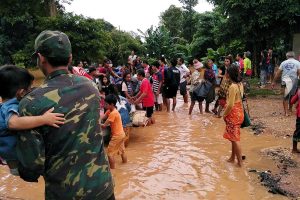By Amy Sawitta Lefevre
BANGKOK (Reuters) – Hundreds of people are missing and several are feared dead after a hydropower dam under construction in southern Laos collapsed, causing flash flooding that swept away homes, state media reported on Tuesday.
The disaster left more than 6,600 people homeless, the Lao News Agency reported. It showed pictures of villagers wading through muddy floodwater carrying belongings. Others boarded rickety wooden boats or stood on the roofs of partially submerged houses.
Officials have brought boats to help evacuate people in San Sai district of Attapeu province, where the Xepian-Xe Nam Noy hydropower dam is located, as water levels rise after the collapse, ABC Laos news reported.
The South Korean company building the dam said heavy rain and flooding caused the collapse and it was cooperating with the Laos government to help rescue villagers near the dam.
“We are running an emergency team and planning to help evacuate and rescue residents in villages near the dam,” a SK Engineering Construction spokesman told Reuters by telephone.
Another official of SK Engineering Construction said the company ordered the evacuation of 12 villages as soon as it became clear that the dam would collapse.
The South Korean foreign ministry said in a text message to reporters that 50 workers of the company and three from Korea Western Power Co. who were stationed at the construction site had been evacuated.
The dam collapsed at 8:00 p.m. local time (1300 GMT) on Monday, releasing 5 billion cubic meters of water and several hundred people are missing after homes were swept away, the Lao News Agency said. It said several people had died.
A video posted by the ABC Laos news on its Facebook page showed villagers stopping to watch the fast-flowing water from the side of a riverbank.
Another showed a distraught woman getting into a wooden boat with her baby, saying that she had to wait to be rescued after the floodwater came and her mother was still trapped in a tree.
The prime minister of the Communist-run Southeast Asian nation, Thongloun Sisoulith, has suspended government meetings and led Cabinet members to monitor rescue and relief efforts in one of the affected areas, the state agency reported.

Villagers carry their belonging as they evacuate after the Xepian-Xe Nam Noy hydropower dam collapsed in Attapeu province, Laos July 24, 2018. REUTERS/Stringer
HYDROPOWER AMBITIONS A WORRY
One of Asia’s poorest and most secretive countries, Laos is landlocked, but aims to become the “battery of Asia” by selling power to neighbors through a series of hydropower dams.
Lao experienced one of its worst natural disasters in 2013 when five major monsoon storms hit the country in a period of three months, according to the ReliefWeb humanitarian information portal. It said that approximately 347,000 people were affected by severe flooding in that disaster.
Environmental rights groups have for years raised concerns about Laos’ hydropower ambitions, including worries over the impact of dams on the Mekong River, its flora and fauna and the rural communities and local economies that depend on it.
The collapsed dam was expected to start commercial operations by 2019 and export 90 percent of its power to Thailand under a Power Purchase Agreement between the Xe-Pian-Xe Namnoy Power Company (PNPC) and the Electricity Generating Authority of Thailand (EGAT).
The remaining 10 percent of power would be sold to the local grid under an agreement between the PNPC and the Electricite du Laos.
PNPC was established in 2012 by SK Engineering & Construction Co., Ltd, Korea Western Power Co. Ltd., Ratchaburi Electricity Generating Holding, Thailand’s largest private power producer, and Lao Holding State Enterprise (LHSE).
Ratchburi Electricity Generating Holding Company said in a statement the dam, which it referred to as ‘Saddle Dam D’, was eight meters (26 feet) wide, 770 meters (2,526 feet) long and 16 meters (52 feet) high.
The dam “was fractured and the water had leaked to the downstream area and down to the Xe-Pian River which is about five kilometers from the dam,” said Kijja Sripatthangkura, chief executive officer of Ratchaburi Electricity Generating Holding Company.
International Rivers, a U.S.-based group that works to protect rivers and the rights of communities dependent on them, said the accident exposed “major risks” associated with some dam designs that cannot cope with extreme weather conditions.
“Unpredictable and extreme weather events are becoming more frequent in Laos and the region due to climate change,” the group told Reuters in an e-mail.
“This also shows the inadequacy of warning systems for the dam construction and operations. The warning appeared to come very late and was ineffective in ensuring people had advance notice to ensure their safety and that of their families.”
(Reporting by Amy Sawitta Lefevre and Ju-min Park; Writing by John Chalmers; Editing by Michael Perry)
 Villagers evacuate after the Xepian-Xe Nam Noy hydropower dam collapsed in Attapeu province, Laos July 24, 2018. ABC Laos News/Handout via REUTERS
Villagers evacuate after the Xepian-Xe Nam Noy hydropower dam collapsed in Attapeu province, Laos July 24, 2018. ABC Laos News/Handout via REUTERS
